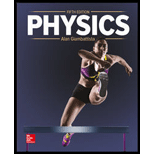
Concept explainers
(a)
The total force on the
(a)
Answer to Problem 117P
The total force on the
Explanation of Solution
The following figure gives the diagram of the total force acting on the body.

Write the expression for the
Here,
Write the expression for the
Here,
Rewrite equation (I) using Coulomb’s force between two charges.
Here,
Rewrite equation (II) using Coulomb’s force between two charges.
Write the expression to find the total magnitude of the force.
Write the expression to find the direction of the force.
Conclusion:
Substitute equation (III) and (IV) in equation (V) to find the magnitude of total force.
Substitute
Substitute equation (III) and (IV) in equation (VI) to find the direction of total force.
Substitute
Therefore, the total force on the
(b)
The electric potential energy of the three charges.
(b)
Answer to Problem 117P
The electric potential energy of the three charges is
Explanation of Solution
Write the expression for the total potential energy of the charges.
Conclusion:
Substitute
Therefore, the electric potential energy of the three charges is
Want to see more full solutions like this?
Chapter 17 Solutions
Physics
 College PhysicsPhysicsISBN:9781305952300Author:Raymond A. Serway, Chris VuillePublisher:Cengage Learning
College PhysicsPhysicsISBN:9781305952300Author:Raymond A. Serway, Chris VuillePublisher:Cengage Learning University Physics (14th Edition)PhysicsISBN:9780133969290Author:Hugh D. Young, Roger A. FreedmanPublisher:PEARSON
University Physics (14th Edition)PhysicsISBN:9780133969290Author:Hugh D. Young, Roger A. FreedmanPublisher:PEARSON Introduction To Quantum MechanicsPhysicsISBN:9781107189638Author:Griffiths, David J., Schroeter, Darrell F.Publisher:Cambridge University Press
Introduction To Quantum MechanicsPhysicsISBN:9781107189638Author:Griffiths, David J., Schroeter, Darrell F.Publisher:Cambridge University Press Physics for Scientists and EngineersPhysicsISBN:9781337553278Author:Raymond A. Serway, John W. JewettPublisher:Cengage Learning
Physics for Scientists and EngineersPhysicsISBN:9781337553278Author:Raymond A. Serway, John W. JewettPublisher:Cengage Learning Lecture- Tutorials for Introductory AstronomyPhysicsISBN:9780321820464Author:Edward E. Prather, Tim P. Slater, Jeff P. Adams, Gina BrissendenPublisher:Addison-Wesley
Lecture- Tutorials for Introductory AstronomyPhysicsISBN:9780321820464Author:Edward E. Prather, Tim P. Slater, Jeff P. Adams, Gina BrissendenPublisher:Addison-Wesley College Physics: A Strategic Approach (4th Editio...PhysicsISBN:9780134609034Author:Randall D. Knight (Professor Emeritus), Brian Jones, Stuart FieldPublisher:PEARSON
College Physics: A Strategic Approach (4th Editio...PhysicsISBN:9780134609034Author:Randall D. Knight (Professor Emeritus), Brian Jones, Stuart FieldPublisher:PEARSON





